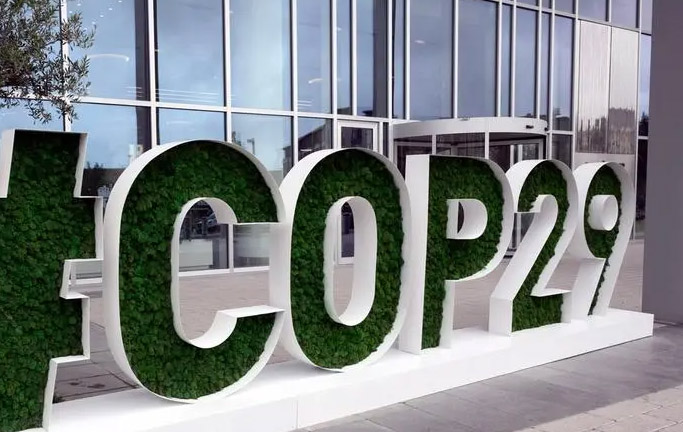By Dr. Gyan Pathak
The 29th Conference of Parties (COP29) to the UN Framework Convention on Climate Change (UNFCCC) at Baku in Azerbaijan must deliver an agreement on increased climate financing target up to the level that is at least necessary, if not enough, to tackle the present climate crisis. It is necessary since the pledge set in 2009 is to expire by this year end, Nationally Determined Contributions (NDCs) commitments are far less than required to reduce the targeted emission level, and there is a huge financing gap to meet the goal of limiting global warming to 1.5 degree Celsius as per Paris Agreement of 2015.
The annual climate financing pledge of $100 billion set in 2009, which expires at the end of the year and which many say is far less than what is required to cope with fast-rising air and sea temperatures, needs to be replaced by a new financing target. The “Adaptation Gap Report 2024: Come Hell and High Water” from the United Nations Environment Programme has said even achieving the Glasgow Climate Pact goal would only reduce the adaptation finance gap, estimated at USD 187-359 billion per year, by around 5 per cent.
Apart from this challenging situation on financial front, there is also an alarming ambition gap in reducing greenhouse gas emissions. According to the 4th edition of the Climate Action Monitor published by the OECD, Nationally Determined Contributions (NDCs) currently commit to a collective reduction in greenhouse gas emissions of only 14% by 2030, compared to 2022 levels, in countries covered by IPAC which produce over 80% of global GHG emissions. This is well short of the estimated 43% global emission reduction needed to limit global warming to 1.5° Paris Agreement goal according to the Intergovernmental Panel on Climate Change (IPCC).
International public finance to help developing countries adapt to climate change increased from USD 22 billion in 2021 to USD 28 billion in 2022, but there remains a huge gap between what is needed and what is being delivered, according the UN’s adaptation gap report. At the UN climate conference in Glasgow in 2021, developed nations were urged to at least double their adaptation funding for developing countries from about USD 19 billion in 2019 by 2025. The UN climate summit in Dubai in December 2023 repeated this call, asking developed countries to report progress in 2024.
UNEP’s Emissions Gap Report, released last month, said the world is on course for a catastrophic temperature rise of 2.6-3.1 degrees Celsius this century without immediate and major cuts to greenhouse gas emissions.
It is in this backdrop, from the first day of COP29, UN and the other stakeholders are pushing for an agreement from the first day of conference for a new climate finance deal. UN Climate Chief Simon Stiell told the negotiators at COP29 on the very first day that setting an ambitious new climate finance target is crucial for the well-being of all nations, including the wealthiest and most powerful “because without it, humanity would be headed towards five degrees of global warming”.
Stiell gave some stark examples of why a new deal on climate finance is so crucial, saying that every country would pay a terrible price if at least two-thirds of the world’s countries cannot afford to rapidly reduce their emissions. Moreover, the entire world economy could collapse if countries are unable to strengthen their supply chains in the face of rising costs linked to climate shocks, such as falling water levels in the Panama Canal which had a dramatic impact on shipping volumes.
“Parties need to agree a way out of this mess. That’s why here in Baku, we must agree a new global climate finance goal,” told Stiell negotiators. He wrapped up his remarks with a reminder of the historic importance of COP29. “We cannot leave Baku without a substantial outcome,” he said, challenging delegates to “stand and deliver.”He called on every nation to show that global cooperation is “rising to this moment” rather than faltering.
As COP29 opened, which will run through November 22, the UN weather agency, WMO released its State of the Climate 2024 Update and issued a Red Alert on the rapid progression of climate change within a single generation, driven by rising levels of greenhouse gases in the atmosphere.
The years 2015-2024 will mark the hottest decade on record, with an accelerating loss of glacial ice, rising sea levels, and heating oceans. Extreme weather is causing significant disruption to communities and economies worldwide.
From January to September 2024, the global mean surface air temperature was 1.54 °C (±0.13°C) above the pre-industrial average, amplified by a warming El Niño, according to an analysis of six international datasets used by the WMO.
The OECD’s Climate Action Monitor has said that for the twelfth consecutive month, the global average temperature was 1.5°C warmer than the pre-industrial era. By August 2024, 15 national temperature heat records were broken across the world. It also says that the lack of legally binding net-zero targets in most countries poses a risk that these commitments may not be fully achieved. Only 27 countries and the European Union, representing 16% of global GHG emissions, have legally enshrined their net-zero targets. Given that countries are soon to submit the next round of NDCs for 2035and Biennial Transparency Reports, it is critical that they address both the ambition and implementation gaps. (IPA


